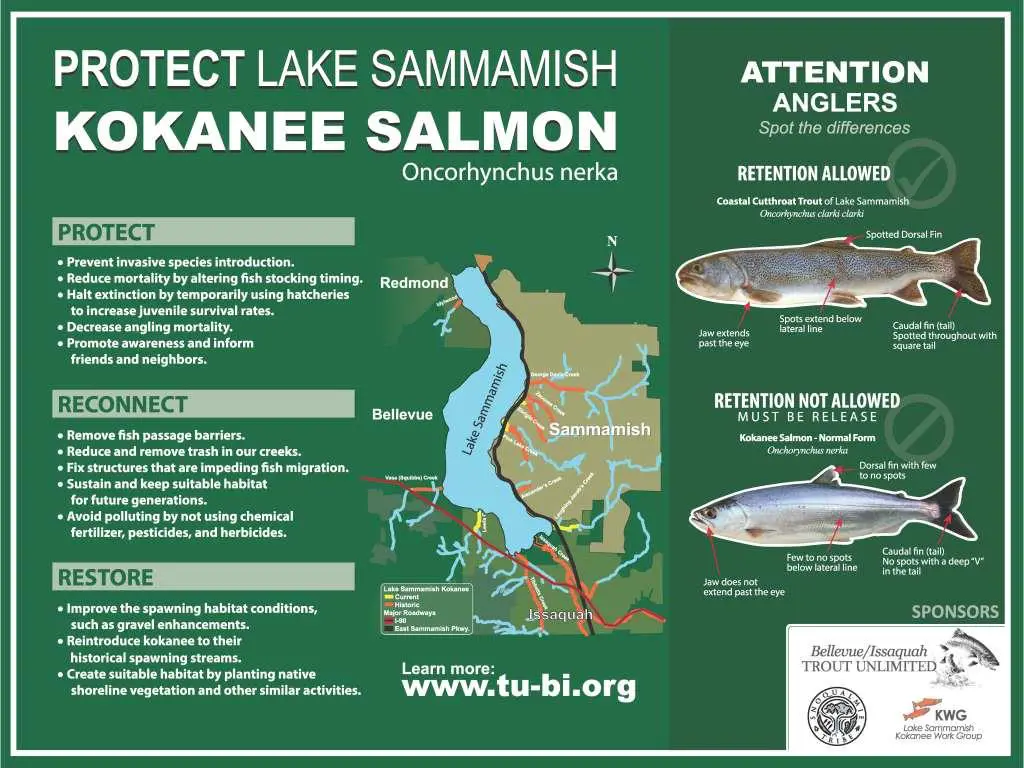Kokanee Restoration in Lake Sammamish
by
David Kyle, July 07, 2019
What is a kokanee?
Before I cover this question, I should introduce myself. My name is David Kyle and I am a Project Manager for Trout Unlimited focused on Lake Sammamish Kokanee restoration. In my job I work on stream habitat reconnection/restoration, education and outreach, and supplementation and research. I have a background in fisheries working at a chinook/steelhead hatchery after high school, fishing/hunting guide in Alaska, received a degree in Fisheries Biology from Humboldt State, and have been lucky enough to work with fish during my professional career. I have been working with Trout Unlimited for 3 years and love my job. You can also find me under the user name “sebastes” on NWFR.
Back to the question which I am sure most of you already know the answer to, kokanee (AKA “little redfish”, “silver trout”, “landlocked sockeye”, or “blueback”) are the non-anadromous form of sockeye salmon (O.nerka) and are distributed through the North Pacific. Kokanee are smaller than their larger cousins averaging 10”-14” in length and weigh 1.5 pounds. These fish hatch in the tributaries of a lake or river, quickly migrate to the larger water body where they primarily feed on Zooplankton (daphnia) for their three to four year lifecycle. Similar to other salmonids, kokanee return to their natal stream to spawn. On Lake Sammamish, the kokanee fishery was closed in the 1980’s and retention is not allowed.
Here in the Puget Sound Region of Washington there are two remaining native populations of kokanee. Of the two native populations, the Lake Washington/Lake Sammamish watershed (just east of Seattle) the kokanee population is in decline. This native kokanee population was historically an important cultural resource for the native people and an important food and recreational resource for the residents of the area. It is estimated that the kokanee population of these lakes numbered in the tens to hundreds of thousands of fish with three distinct runs. Prior to the completion of the Lake Washington Ship Canal (1916) and rerouting of the Cedar River, historical fisheries surveys conducted in the late 19th century showed kokanee were the most common pacific salmon in the watershed with few observations of anadromous sockeye and no accounts of other anadromous salmon species.
The distinct runs of kokanee in the Lake Washington/Sammamish watershed included the “Early”, ”Middle”, and “Late” Runs. The Early run spawned in Issaquah Creek and is believed to have been extirpated due to past hatchery practices. The Middle Run occupied Lake Washington/Sammamish River and is believed to have either blinked out or hybridized with Baker Lake Sockeye. Today, it is believed that only the native “Late” Run remains and exists in Lake Sammamish. The Late Run’s 10 year average return is 800 adults but is highly variable ranging from a high of 15,000 to a low of 19 fish.
Extremely low and highly variable kokanee returns highlight the need of restoration of this fish. Trout Unlimited has partnered with an ad hoc group called the Kokanee Working Group (KWG) which was formed 2007. The goals of the KWG encompass returning the kokanee population to robust health and ultimately re-establishing a fishery, which was closed in the 1980’s, for kokanee on the lake. The KWG membership includes watershed residents, each of the five local jurisdictions in the Lake Sammamish watershed, the US Fish and Wildlife Service, the Washington Department of Fish and Wildlife, Washington State Parks, the Snoqualmie Tribe, Trout Unlimited, Friends of Issaquah Salmon Hatchery, Save Lake Sammamish, Friends of Pine Lake, and additional stakeholders. Our restoration work includes: stream restoration/reconnection, daylighting streams, replacement of fish passage barriers, public outreach, stormwater control, hatchery supplementation, and research into the issues effecting kokanee in Lake Sammamish.
A recent development in the kokanee world, thanks to the fishermen and reports on Northwest Fishing Reports, we have hope that some of the “Middle” Run of kokanee which occupied Lake Washington may persist. Many thanks to Mike Carey and Randy Costello, who saved and donated the carcasses of the “kokanee” they caught in Lake Washington. We will process the fish by extracting their Otoliths and running the genetics. From the samples we will be able to determine age, any saltwater exposure, and compare the genetics to historical samples to determine origin.
There are a lot of interesting things happening in the Lake Sammamish kokanee world, I will continue to provide NWFR with updates on the health of the kokanee run, exciting kokanee related events or projects happening, and ways to participate. If you want to know more about the kokanee restoration effort, volunteer for our citizen science opportunities, or participate in one of our events, check out
lakesammamishkokanee.comor email me at dkyle@tu.org
Comments
Why is this comment inappropriate?
Delete this comment? Provide reason.


